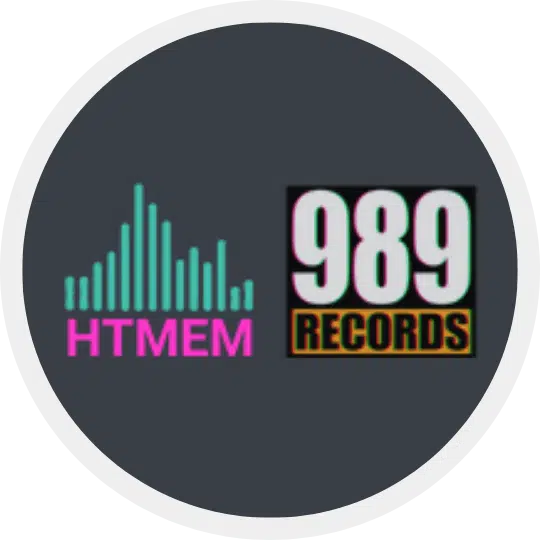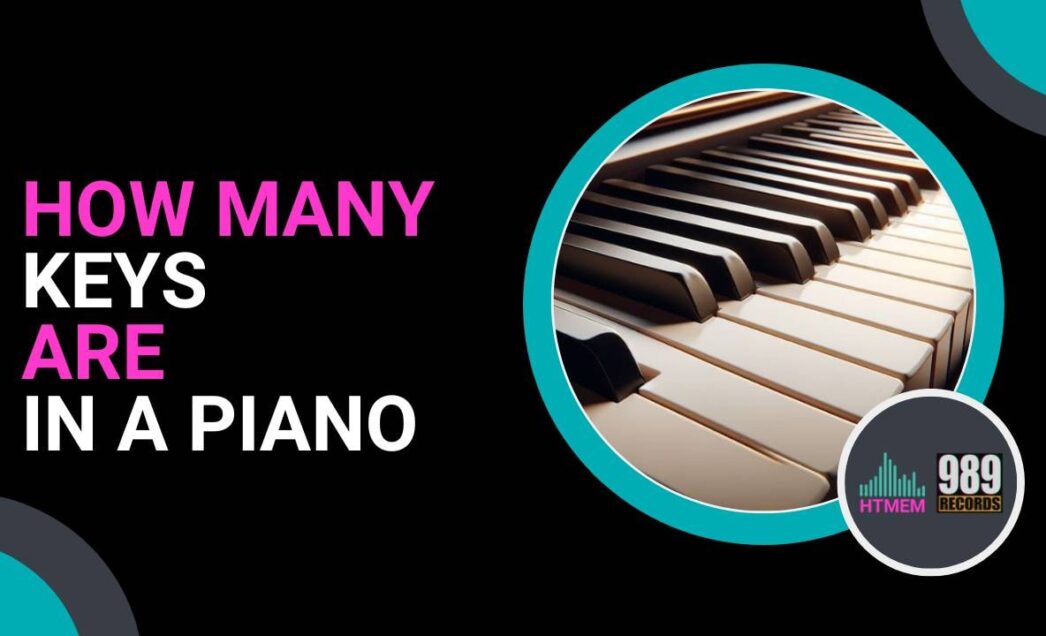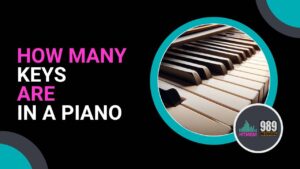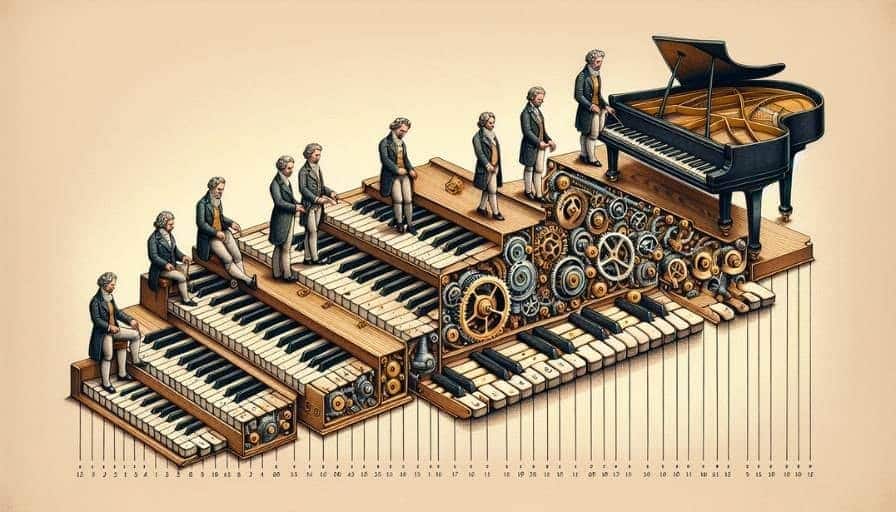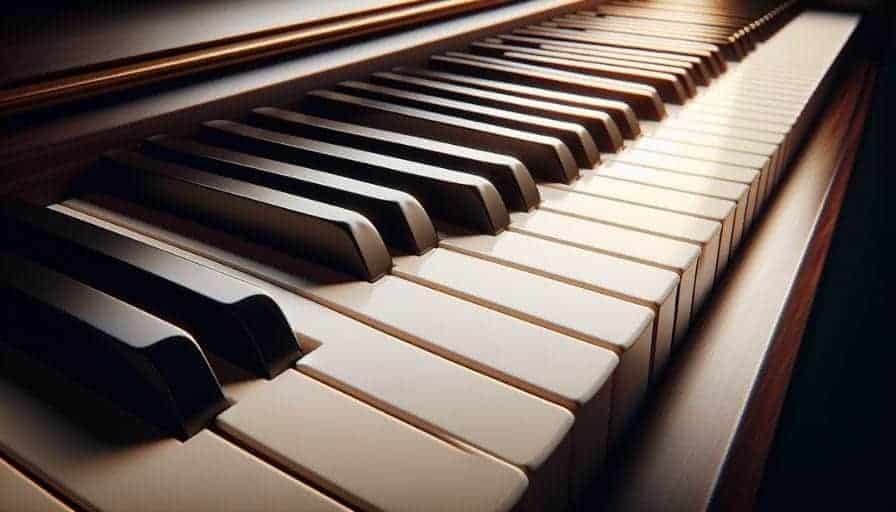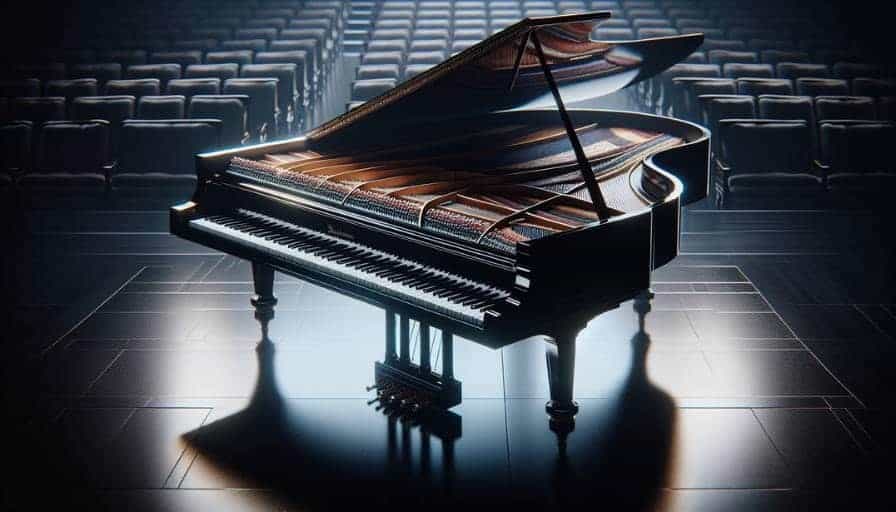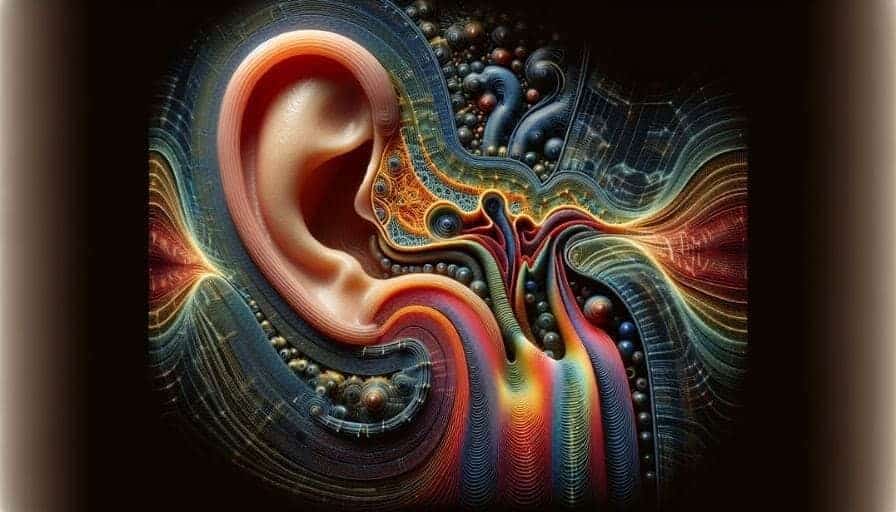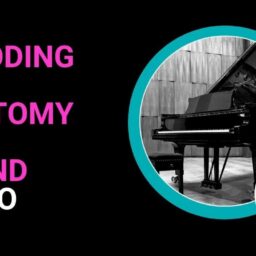Curious about the keys of a piano? If you’ve ever wondered “How Many Keys Are in a Piano?”, standard pianos have 88 keys. Read on to discover why and how this shapes the music we love.
Key Takeaways
- The standard 88-key piano evolved from early keyboards with fewer octaves as composers and musicians sought a greater musical range for expanding musical expression, leading to a standardized layout by the 1870s due to musical demand, versatility, and technical compositions.
- A modern piano keyboard comprises 7 1/4 octaves, with a pattern of 52 white and 36 black keys repeating every 12 keys, facilitating play in any key signature and allowing a vast range of compositions and improvisation.
- While the 88-key piano remains the standard, variations exist including pianos with more or fewer keys to meet diverse user needs and preferences. However, challenges in discerning extra notes with the human ear limit the practical extension of range.
Understanding the Piano Keyboard Instrument
The piano is a versatile keyboard instrument that has been a cornerstone of music-making for centuries. With its rich, expressive sound and wide range of tonal possibilities, it’s no wonder that the piano remains a popular choice for musicians of all levels. But have you ever stopped to think about the piano’s keyboard layout and design? The arrangement of piano keys is not just a random assortment; it’s a carefully crafted system that allows for a vast array of musical expressions. Each key, whether black or white, plays a crucial role in the creation of piano music, making this instrument unique in its ability to convey complex melodies and harmonies.
The Evolution of Piano Keys
The journey of the first piano, as we know it today, began around 1700 with Bartolomeo Cristofori’s invention of a keyboard instrument featuring a total of 49 keys.
Initially, the early piano keyboards saw variations in their arrangement of white and black keys and even the development of enharmonic keyboard layouts to address musical and technical issues.
As composers sought to expand their musical expression, this led to the invention of pianos with more keys, paving the way for a wider musical range. By the 1870s, the 88-key piano had emerged and was popularized, becoming the modern standard for grand pianos and upright pianos alike. This standardization was influenced by a variety of factors, including:
- The range of music composers were writing at the time
- The desire for greater musical versatility
- The need to accommodate the growing complexity of musical compositions
The 88-key piano has since become the standard for pianos, allowing musicians to explore various musical possibilities.
Early Pianos and Key Expansion
In the early stages of piano music history, pianos had a limited range, often with a keyboard of fewer than five octaves.
However, composers such as Haydn and Mozart were instrumental in expanding the piano keys during their era, pushing the boundaries of musical expression and leading to a significant increase in the number of keys.
This expansion resulted in a range that extended from the common five octaves of Mozart’s time to over seven octaves found in modern-day pianos. As keyboards grew beyond the typically limited octaves of the classical period, the numbering of piano keys with specific pitch numbers was established, ensuring accurate scale representation.
The Standardization of 88 Keys
The invention of the first 88-key piano by Steinway set a new precedent for piano design. Popularized in the 1880s, this marked a pivotal moment in music history, as the 88-key piano became the standard for grand and upright pianos.
Adopting the 88-key layout was influenced by the range of music composition, practical considerations, and the limitations of human auditory perception. This standardization allowed for a uniform playing experience across different piano manufacturers, enabling musicians to perform a wider range of compositions.
Anatomy of a Piano Keyboard
A standard modern piano, whether it’s a digital piano or an acoustic one, boasts a total of 52 white keys and 36 black keys. This combination translates into 7 1/4 octaves, providing a variety of notes for musicians to express their creativity.
Each octave on a piano includes seven natural notes, and together with five accidental notes, forms a repeating 12-key pattern across the keyboard. This unique structure enables musicians to play in any key signature, from C major scale to any other scale, granting unlimited possibilities for composition and improvisation.
Understand how to Master the Circle of Fifths
Black and White Keys
The black and white keys on a piano offer musicians a complete chromatic scale for music composition and performance. The concept of white keys C, D, E, F, G, A, and B (also known as natural notes) dates back to the third century and is linked to the hydraulis musical notes, while the black keys (also known as accidentals notes) were included in the 14th century to build upon the seven original white keys.
Each octave on a piano is comprised of five black keys, positioned as:
- C# or Db
- D# or Eb
- F# or Gb
- G# or Ab
- A# or Bb
Curious about how many black keys there are? These black keys, also known as accidental keys or enharmonic notes, and the seven white keys, form the chromatic scale and allow musicians to modulate to any key and express a vast array of emotions in their compositions.
Octaves and Natural Notes
The piano keyboard, a type of musical instrument, has its roots in the hydraulis, an ancient Greek instrument, and retains the seven basic natural notes that form the diatonic scales:
- C
- D
- E
- F
- G
- A
- B
The keyboard expanded from its initial range of three or four octaves during the Renaissance to the Classical periods, reaching over five octaves to accommodate the growing demand for a wider range of musical expression, including classical music.
Curious about how many octaves are on a standard piano? In an octave on the piano, whole tones are intervals with a distance of two semitones, found between adjacent natural notes such as C to D, and D to E. This interval excludes the E to F and B to C intervals which are semitones.
A standard piano has seven full octaves plus three extra notes, spanning from A0 (lower) to C8 (higher), with the middle C represented as C4.
Piano Key Layout and Design
The standard piano keyboard consists of 88 keys, divided into 52 white keys and 36 black keys. The white keys are arranged in a pattern of seven natural notes (A, B, C, D, E, F, and G), while the black keys are grouped into sets of two and three to form sharps and flats. This layout allows for a wide range of tonal possibilities and makes it possible for pianists to play complex melodies and harmonies with ease. But did you know that the piano’s keyboard design has evolved over time? In the early days of piano-making, instruments often had fewer keys, and it wasn’t until the late 19th century that the modern 88-key piano became the standard. This evolution was driven by the demands of composers and musicians who sought a greater range of notes to express their musical ideas.
Beyond the Standard: Pianos with More or Fewer Keys
While the standard 88-key piano dominates the musical landscape, variations exist to furnish different needs and preferences. These include pianos with more or fewer keys than the standard 88, often incorporating a weighted action to simulate the feel of an acoustic piano.
Pianos with fewer keys are typically chosen by amateur or experimental pianists who may find them less intimidating and more approachable.
On the other end of the spectrum, some grand pianos feature more keys, extending the instrument’s range and offering unique possibilities for composers and performers.
Pianos with Extra Keys
Some piano makers, like Bösendorfer and Stuart & Sons, have taken the grand piano to new heights by introducing grand pianos with more than the standard 88 keys. These additional keys provide pianists with expanded ranges, opening up new possibilities for musical expression. my beloved Fazioli, another prominent piano Italian manufacturer, has also embraced the concept of extended-range pianos, offering models that reach as low as ‘C0’.
While these extra keys are often used for ornamental purposes, some modern compositions specifically call for the use of these extended notes.
The highest number of keys on a piano to date is 108, but the discernibility of these extra notes is often challenging due to the limitations of the human ear.
Smaller Keyboards and Digital Pianos
On the other hand, smaller keyboards and digital pianos usually come with 61, 76, or 88 keys.
These instruments are designed with beginners in mind, offering 88 keys and weighted action to approximate the feel of an acoustic piano. A keyboard with fewer keys can help beginners focus on learning the basic notes and chords without being overwhelmed.
Models like the Roland FP-10 are advised for novices, thanks to their affordability, portability, and approximation to a grand piano’s sound and touch. For intermediate and advanced players, digital pianos like the Casio CDP-S360 provide comprehensive features including a wide variety of sounds and the capability to record performances.
Understanding Pitch and Sound Range in Pianos
Understanding the pitch and sound range of pianos, including high and low notes, is crucial for every pianist.
The equal-tempered scale in pianos ensures that musicians can play scales accurately starting from any of the 12 half-step notes. Ear training is equally important, as it enhances the ability to understand the instrument’s range by recognizing the notes on a piano by their sound and pitch.
This understanding enables musicians to navigate the keyboard confidently, perform compositions accurately, and even create their own music.
High and Low Notes
The wide range of piano keys offers musicians the ability to express a vast array of emotions and dynamics in their music. A wider range of notes allows for:
- More varied and richer musical compositions
- Greater flexibility in creating melodies and harmonies
- The ability to play a wider range of musical genres and styles
The wide range of piano keys is essential for musicians to fully explore their creativity and create beautiful music.
Pianos with extra keys, such as those from Bösendorfer, possess a unique resonance when the dampers are lifted. This feature can enhance the bass section thanks to additional strings and a soundboard area. However, these 97-key pianos, with 9 additional black keys, are predominantly used to augment the richness of sound in conjunction with other keys, rather than direct use in compositions.
Learn how to Master the Circle of Fifths
Human Ear Limitations
Human ears can hear sounds in a range between 20 Hz and 20,000 Hz, with the ability to comprehend and distinguish sound frequencies up to around 4,000 Hz. The highest key on a piano is tuned to approximately 4186 hertz, which approaches the limit of frequency discrimination in human hearing.
Due to these limitations of human hearing range, adding keys beyond the standard 88 has been deemed unnecessary as they would produce frequencies that are beyond human perception.
Therefore, while pianos with extra keys offer unique resonance and enriched sounds, the discernibility of these extra notes is often challenging for human auditory perception.
Memorizing Piano Keys and Music Theory
Memorizing piano keys and music theory can seem daunting, but with practice and dedication, it’s definitely achievable. One way to start is by learning the names of the notes and their corresponding keys. You can use flashcards or online resources to help you memorize the notes, and then practice playing them on the piano. Another way to improve your music theory skills is by learning the major and minor scales, as well as chord progressions. By understanding how music theory works, you’ll be able to play more complex pieces and improvise with confidence. Remember, the key to mastering the piano is consistent practice and a solid understanding of the fundamentals.
Tips for Learning Piano
Learning to play the piano takes time and effort, but with the right approach, you can make rapid progress. Here are some tips to get you started:
- Start with the basics: Begin by learning the names of the notes and their corresponding keys. Practice playing simple melodies and exercises to build your hand-eye coordination and fine motor skills.
- Practice regularly: Consistency is key when it comes to learning piano. Set aside time each day to practice, even if it’s just for a few minutes.
- Use technology to your advantage: There are many online resources and apps available that can help you learn piano, from video lessons to interactive games and exercises.
- Find a good teacher: Working with a qualified piano teacher can help you improve faster and avoid developing bad habits.
Choosing the Right Piano for Your Needs
Choosing the right piano for your needs involves considering your skill level, the physical space available, and your musical goals.
Beginner pianists may find fewer keys less intimidating, making it easier to get started with learning how to play the instrument. On the other hand, intermediate and advanced pianists might require a full 88-key piano to support their technical proficiency and musicianship.
The key to finding that perfect instrument lies in understanding the nuances of piano keys and how they contribute to the instrument’s versatility and expressive range.
Beginner Pianists
For beginners, a keyboard with fewer keys can help them focus on learning the basic notes and chords without being overwhelmed. Digital pianos often have the advantage of being more affordable and portable, making them a practical choice for beginners.
Models like the Roland FP-10 are advisable for novices due to their:
- Affordability
- Portability
- Approximation of a grand piano’s sound and touch
- Features conducive to learning such as a keyboard split function for duet play
Limited physical space in a home or studio may also make a smaller keyboard or digital piano with fewer keys a practical choice.
Intermediate and Advanced Pianists
For intermediate players who can play Major and Harmonic Minor scales from memory and who understand arpeggios, a full 88-key piano is advisable to facilitate their growing technical proficiency and musicianship. These pianos provide a richer sound and a wider range of musical expression, allowing musicians to explore complex compositions and enhance their piano skills.
Advanced players might opt for digital pianos like the Casio CDP-S360 which provides comprehensive features including a wide variety of sounds and the capability to record performances. This allows them to experiment with different sounds, record their performances for review, and even share their music with others.
Piano Maintenance and Care
To keep your piano in good working order, it’s essential to perform regular maintenance and care. Here are some tips to help you keep your piano sounding its best:
- Dust regularly: Use a soft cloth to dust the keys and exterior of the piano, paying special attention to the areas around the pedals and hinges.
- Tune regularly: Depending on how often you play, you may need to tune your piano every 6-12 months. Use a professional tuner to ensure that your piano is properly tuned and adjusted.
- Avoid extreme temperatures: Keep your piano away from direct sunlight, radiators, and air conditioning vents, as extreme temperatures can cause the wood to expand and contract.
- Use a piano cover: When not in use, cover your piano with a soft cloth or piano cover to protect it from dust and debris.
By following these tips, you can ensure that your piano remains in excellent condition, providing you with years of musical enjoyment.
Summary
In conclusion, the piano has evolved from a 49-key instrument to a standard 88-key marvel, thanks to the influence of composers and practical considerations. Whether it’s a grand piano, an upright piano, or a digital piano, each instrument offers a unique playing experience and a vast array of notes for musical expression. Understanding the intricacies of piano keys and their evolution can help you appreciate the instrument’s versatility and enrich your musical journey.
So, whether you’re just starting your piano lessons or you’re a seasoned pianist, remember – every key on the piano is a stepping stone to a world of musical possibilities.
Frequently Asked Questions
How many keys are on a full-size piano?
A full-sized piano has 88 keys, with some variations in other piano sizes that can have fewer or more keys, such as 44 to 97 keys. The largest piano has 108 keys, but these are rare.
Is 61 Keys a full piano?
No, a full piano typically has 88 keys spanning just over seven octaves. Smaller keyboards or synthesizers may have fewer keys, such as 61 keys.
Is there a 100-key piano?
Yes, there is a piano with 108 keys, allowing for an extended range beyond the standard 88 keys commonly found in most pianos. This unique piano was created by Australian piano maker Stuart & Sons, making it the first acoustic piano with a nine-octave keyboard.
What notes do the white and black keys on a piano represent?
The white keys on a piano represent natural notes, while the black keys serve as accidental or enharmonic notes.
What is the range of human hearing, and how does it relate to the piano keys?
The range of human hearing is between 20 Hz and 20,000 Hz. The highest key on a piano is tuned to approximately 4186 hertz, which is close to the upper limit of frequency discrimination in human hearing.
Suggested Readings
Cubase Chord Progression Builder
Chord Progression Chart
Mastering the Circle of Fifths
Practice and Enjoy!
